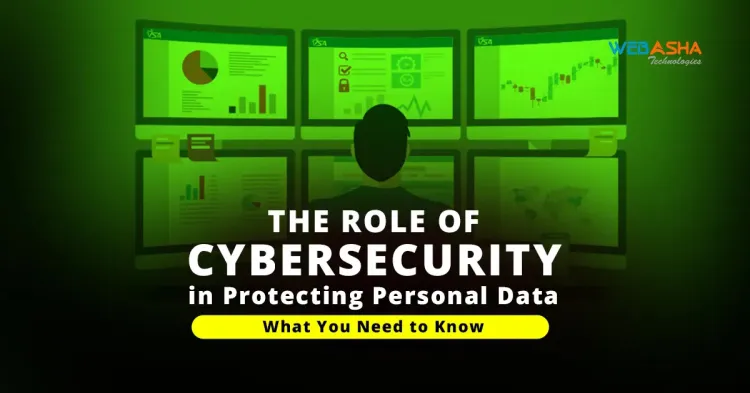The Role of Cybersecurity in Protecting Personal Data: What You Need to Know in 2025
Learn about the crucial role of cybersecurity in protecting personal data. This article covers key measures such as encryption, access controls, and data backup, and discusses compliance with regulations like GDPR, CCPA, and HIPAA. Discover emerging trends and practical tips for safeguarding your personal information from cyber threats.

In an age where personal data is increasingly digital and interconnected, protecting this sensitive information has become a critical priority. Cybersecurity plays a pivotal role in safeguarding personal data from unauthorized access, breaches, and misuse. Understanding how cybersecurity contributes to data protection is essential for individuals and organizations alike. Here’s what you need to know about the role of cybersecurity in protecting personal data.
What is Cybersecurity?
Cybersecurity refers to the practice of protecting computers, servers, networks, and data from malicious attacks, damage, or unauthorized access. It encompasses a wide range of technologies, processes, and practices designed to safeguard digital assets and ensure the confidentiality, integrity, and availability of information.
Key Aspects of Cybersecurity:
-
Confidentiality:
Ensuring that information is accessible only to those authorized to view it. Confidentiality is achieved through methods such as encryption, access controls, and secure authentication. -
Integrity:
Maintaining the accuracy and completeness of data. This involves protecting data from being altered or corrupted by unauthorized individuals. Integrity measures include data validation, hashing, and checksums. -
Availability:
Ensuring that information and resources are accessible to authorized users when needed. This involves implementing redundancy, disaster recovery plans, and protection against denial-of-service attacks.
Core Areas of Cybersecurity:
-
Network Security:
Protecting the network infrastructure from attacks, unauthorized access, and breaches. This includes the use of firewalls, intrusion detection systems, and network segmentation. -
Endpoint Security:
Securing individual devices such as computers, smartphones, and tablets from threats. This includes antivirus software, device encryption, and regular updates. -
Application Security:
Ensuring that software and applications are designed and maintained to resist security threats. This includes practices such as code review, vulnerability scanning, and secure coding techniques. -
Information Security:
Protecting data, both in transit and at rest, from unauthorized access and breaches. This involves data encryption, access controls, and secure data storage practices. -
Operational Security:
Managing and protecting the processes and procedures used to handle and protect data. This includes implementing security policies, monitoring systems, and conducting security training for employees. -
Incident Response:
Preparing for and responding to security breaches and cyberattacks. This includes developing incident response plans, conducting forensic investigations, and mitigating the impact of incidents. -
Disaster Recovery:
Planning and implementing strategies to recover data and restore operations after a cyberattack or data loss event. This involves regular backups, redundancy, and recovery procedures.
Importance of Cybersecurity:
-
Protects Sensitive Information:
Safeguards personal, financial, and business data from theft and misuse. -
Prevents Financial Loss:
Helps avoid the costs associated with data breaches, cyberattacks, and legal consequences. -
Maintains Trust:
Ensures that customers and stakeholders have confidence in the organization’s ability to protect their information. -
Supports Compliance:
Helps organizations adhere to regulatory requirements and industry standards for data protection.
Challenges in Cybersecurity:
-
Evolving Threats:
Cyber threats are constantly changing, requiring continuous adaptation and vigilance. -
Complexity of IT Environments:
Managing security across diverse and complex IT infrastructures can be challenging. -
Human Factors:
Social engineering attacks and human errors can compromise security, highlighting the need for effective training and awareness.
Cybersecurity is a dynamic and critical field, essential for protecting digital assets and maintaining the security and privacy of information in an increasingly connected world.
1. Understanding Personal Data
What is Personal Data?
Personal data refers to any information that can identify an individual, either directly or indirectly. This includes names, addresses, social security numbers, financial information, and more. With the rise of digital services, personal data is often collected, stored, and processed online, making it a prime target for cybercriminals.
Why Protecting Personal Data is Crucial:
Securing personal data is vital to prevent identity theft, financial loss, and privacy violations. Unauthorized access to personal information can lead to significant harm, including fraud and reputational damage.
2. Key Cybersecurity Measures for Protecting Personal Data
Encryption:
Encryption transforms data into a secure format that can only be read by authorized parties. By encrypting personal data both in transit and at rest, organizations ensure that even if data is intercepted, it remains unreadable to unauthorized users.
Access Controls:
Access controls restrict who can view or modify personal data. Implementing strong authentication methods, such as multi-factor authentication (MFA), and regularly reviewing user access levels helps protect sensitive information from unauthorized access.
Firewalls and Intrusion Detection Systems:
Firewalls act as barriers between trusted internal networks and untrusted external networks, blocking malicious traffic. Intrusion Detection Systems (IDS) monitor network traffic for suspicious activities, alerting administrators to potential breaches.
Regular Software Updates:
Keeping software and systems up-to-date ensures that known vulnerabilities are patched. Cybercriminals often exploit outdated software to gain unauthorized access, so regular updates are a crucial part of data protection.
Data Backup:
Regularly backing up data ensures that personal information can be restored in case of a cyberattack or data loss incident. Backups should be stored securely and tested periodically to ensure their effectiveness.
Employee Training:
Educating employees about cybersecurity best practices and potential threats helps prevent human error, which is a common factor in data breaches. Training should cover topics such as recognizing phishing attempts and using strong passwords.
3. Compliance with Data Protection Regulations
General Data Protection Regulation (GDPR):
GDPR is a comprehensive data protection law in the European Union that mandates how personal data should be handled. It requires organizations to obtain explicit consent from individuals before collecting their data and to implement measures to protect it.
California Consumer Privacy Act (CCPA):
CCPA provides California residents with rights over their personal data, including the right to know what data is being collected and to request its deletion. Organizations must comply with CCPA to avoid legal penalties and protect consumer privacy.
Health Insurance Portability and Accountability Act (HIPAA):
HIPAA sets standards for protecting sensitive health information in the United States. It requires healthcare providers and related organizations to implement strict data protection measures to safeguard patient information.
4. Emerging Trends in Data Protection
Artificial Intelligence and Machine Learning:
AI and machine learning technologies are increasingly being used to enhance cybersecurity. These technologies can analyze vast amounts of data to detect unusual patterns and potential threats more efficiently than traditional methods.
Zero Trust Security:
Zero Trust Security is an approach that assumes no user or device is inherently trusted. It requires continuous verification and validation of all users and devices accessing the network, reducing the risk of unauthorized access.
Privacy-Enhancing Technologies (PETs):
PETs focus on minimizing data collection and enhancing privacy. Techniques such as data anonymization and pseudonymization help protect personal information while still allowing organizations to use data for legitimate purposes.
5. How Individuals Can Protect Their Personal Data
Use Strong, Unique Passwords:
Create complex passwords for different accounts and use a password manager to keep track of them. Avoid using easily guessable information, such as birthdays or common words.
Be Wary of Phishing Scams:
Be cautious when clicking on links or opening attachments in emails from unknown sources. Phishing scams often trick individuals into revealing personal information or downloading malware.
Enable Two-Factor Authentication:
Use two-factor authentication (2FA) whenever possible to add an extra layer of security. 2FA requires a second form of verification, such as a code sent to your phone, in addition to your password.
Regularly Monitor Financial Statements:
Keep an eye on your bank and credit card statements for any unauthorized transactions. Report any suspicious activity immediately to your financial institution.
Secure Your Devices:
Install antivirus software, enable firewalls, and keep your operating system and applications up-to-date. Secure your devices with passwords or biometric authentication to prevent unauthorized access.
Conclusion
Cybersecurity is fundamental to protecting personal data in today’s digital world. By understanding and implementing key cybersecurity measures, complying with data protection regulations, and staying informed about emerging trends, individuals and organizations can effectively safeguard sensitive information from cyber threats. Prioritizing cybersecurity not only helps in avoiding potential risks but also builds trust and ensures the security of personal data.
FAQs
1. Why is protecting personal data important in cybersecurity?
Protecting personal data is crucial to prevent identity theft, financial loss, and privacy breaches. With personal data being a primary target for cybercriminals, safeguarding this information helps mitigate risks and ensures the security and confidentiality of individuals' sensitive information.
2. What are some effective cybersecurity measures for protecting personal data?
Effective cybersecurity measures include encryption of data, implementing strong access controls, using firewalls and intrusion detection systems, regularly updating software, backing up data, and providing employee training on cybersecurity best practices.
3. How does encryption help in protecting personal data?
Encryption converts data into a secure format that can only be read by authorized parties. This ensures that even if data is intercepted by unauthorized users, it remains unreadable and secure, protecting personal information from exposure.
4. What are access controls and why are they important?
Access controls restrict who can access or modify personal data. They include methods such as multi-factor authentication and user permission levels. These controls are important because they prevent unauthorized individuals from accessing sensitive information, reducing the risk of data breaches.
5. What are the key data protection regulations and their significance?
Key data protection regulations include GDPR, CCPA, and HIPAA. GDPR mandates explicit consent for data collection in the EU, CCPA provides California residents with rights over their data, and HIPAA sets standards for protecting health information in the US. Compliance with these regulations is crucial for protecting personal data and avoiding legal consequences.
6. How can artificial intelligence (AI) and machine learning improve data protection?
AI and machine learning enhance data protection by analyzing large volumes of data to detect unusual patterns and potential threats. These technologies can identify and respond to threats more efficiently than traditional methods, improving overall cybersecurity.
7. What is Zero Trust Security and how does it protect personal data?
Zero Trust Security assumes that no user or device is inherently trusted, regardless of their location. It requires continuous verification of all users and devices accessing the network, reducing the risk of unauthorized access and protecting personal data from potential breaches.
8. What are Privacy-Enhancing Technologies (PETs) and how do they help in data protection?
Privacy-Enhancing Technologies (PETs) focus on minimizing data collection and enhancing privacy. Techniques such as data anonymization and pseudonymization protect personal information while still allowing organizations to use data for legitimate purposes, thus safeguarding privacy.
9. What can individuals do to protect their personal data online?
Individuals can protect their personal data by using strong, unique passwords, being cautious of phishing scams, enabling two-factor authentication, monitoring financial statements for unauthorized transactions, and securing their devices with antivirus software and firewalls.












![Top 10 Ethical Hackers in the World [2025]](https://www.webasha.com/blog/uploads/images/202408/image_100x75_66c2f983c207b.webp)



![[2025] Top 100+ VAPT Interview Questions and Answers](https://www.webasha.com/blog/uploads/images/image_100x75_6512b1e4b64f7.jpg)







